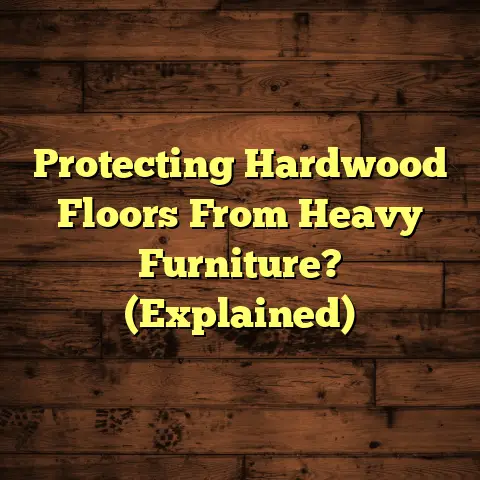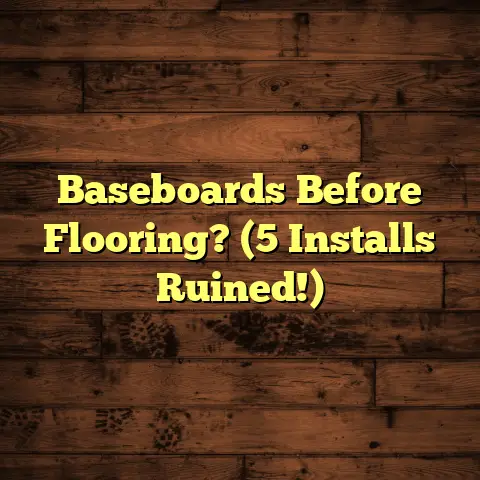Vinyl Flooring Outside? (9 Year Lifespan?)
Will It Last Just 9 Years?
Picture this: the sun is setting, casting a warm glow over your beautifully designed patio.
Friends are laughing, drinks are clinking, and underfoot is…vinyl flooring?
Yes, vinyl! It promises durability, style, and affordability, making it an attractive option for transforming outdoor spaces.
But can this seemingly perfect solution really withstand the test of time?
Will it crack, fade, or peel after just a few seasons? And what about that 9-year lifespan rumor?
Let’s dive in and uncover the surprising truth about vinyl flooring outdoors.
Section 1: The Rise of Vinyl Flooring
Vinyl flooring has come a long way since its humble beginnings.
From its initial introduction as a resilient and water-resistant material, it has evolved into a versatile and stylish option for both indoor and outdoor applications.
I remember when vinyl was primarily used in kitchens and bathrooms due to its waterproof properties.
But now, with advancements in manufacturing and design, it’s become a popular choice for patios, decks, and outdoor living areas.
So what makes vinyl so appealing?
Well, for starters, it’s incredibly water-resistant, making it ideal for outdoor environments where moisture is a constant concern.
Unlike wood, vinyl won’t rot or warp when exposed to rain or humidity.
It’s also relatively easy to maintain.
A quick sweep or mop is usually all it takes to keep it looking its best.
And let’s not forget about the design options!
Vinyl flooring comes in a wide variety of colors, patterns, and textures, allowing homeowners to create the perfect look for their outdoor space.
I’ve seen some incredible transformations where homeowners have used vinyl to mimic the look of wood, stone, or even tile, without the high cost and maintenance.
I’ve even had clients tell me how much they love the softer feel of vinyl underfoot compared to harder surfaces like concrete or stone.
It’s a small detail, but it can make a big difference in the overall comfort and enjoyment of an outdoor space.
But, it’s not all sunshine and roses.
I’ve also seen vinyl flooring installations that have gone wrong, leading to disappointment and frustration.
That’s why it’s so important to understand the potential pitfalls and challenges of using vinyl outdoors.
Section 2: The 9-Year Lifespan Myth
Alright, let’s address the elephant in the room: the 9-year lifespan myth.
Is it true that vinyl flooring outdoors will only last for about a decade?
Well, the answer is…it depends.
The lifespan of vinyl flooring in an outdoor setting is influenced by a variety of factors, including:
-
Climate: Harsh weather conditions, such as extreme temperatures, heavy rain, and snow, can take a toll on vinyl flooring.
-
UV Exposure: Prolonged exposure to the sun’s harmful UV rays can cause vinyl to fade, crack, or become brittle over time.
-
Installation: Proper installation is crucial for the longevity of vinyl flooring.
If it’s not installed correctly, it can be more susceptible to damage and deterioration.
-
Quality of Materials: The quality of the vinyl itself plays a significant role in its durability.
Higher-quality vinyl is typically more resistant to wear and tear than lower-quality options.
According to a report by the Vinyl Institute, the average lifespan of vinyl flooring indoors is typically between 10 and 20 years.
However, that number can vary significantly when vinyl is used outdoors.
I’ve seen some outdoor vinyl installations that have lasted for 15 years or more with proper maintenance and care.
On the other hand, I’ve also seen installations that have failed after just a few years due to poor installation or exposure to harsh weather conditions.
One of the biggest misconceptions about vinyl flooring outdoors is that it’s completely maintenance-free.
While it’s true that vinyl is relatively easy to clean, it still requires regular maintenance to prevent damage and extend its lifespan.
For example, it’s important to sweep or hose off vinyl flooring regularly to remove dirt, debris, and other contaminants.
You should also consider using a UV-resistant sealer to protect the vinyl from sun damage.
And if you live in an area with harsh winters, it’s a good idea to cover your vinyl flooring with a tarp or other protective material to prevent damage from snow and ice.
Here’s a table summarizing the factors affecting vinyl flooring lifespan:
| Factor | Impact | Mitigation Strategies |
|---|---|---|
| Climate | Extreme temperatures, rain, snow can cause cracking, warping, and fading. | Choose weather-resistant vinyl, use protective covers during harsh seasons. |
| UV Exposure | Fading, brittleness, and discoloration due to prolonged sun exposure. | Apply UV-resistant sealers regularly, use shading structures like pergolas or umbrellas. |
| Installation | Improper installation can lead to water damage, uneven surfaces, and premature wear. | Hire professional installers, ensure proper subfloor preparation and drainage. |
| Material Quality | Lower-quality vinyl is more susceptible to damage and wear compared to higher-quality options. | Invest in high-quality vinyl flooring with UV and weather resistance. |
| Maintenance | Lack of regular cleaning and maintenance can accelerate deterioration. | Sweep and wash regularly, promptly address spills, and reapply sealers as needed. |
| Foot Traffic | High foot traffic can cause wear and tear, especially in high-traffic areas. | Use mats and rugs in high-traffic areas, choose vinyl with a higher wear layer. |
| Furniture | Heavy or sharp furniture can scratch or dent the vinyl surface. | Use furniture pads or coasters, avoid dragging heavy items across the surface. |
| Chemical Exposure | Exposure to harsh chemicals or cleaning agents can damage or discolor the vinyl. | Use pH-neutral cleaners, avoid harsh chemicals and solvents. |
| Drainage | Poor drainage can lead to water accumulation and damage to the subfloor. | Ensure proper drainage, slope the surface away from structures. |
| Subfloor | An uneven or unstable subfloor can cause the vinyl to crack or shift. | Ensure the subfloor is level, stable, and properly prepared before installation. |
| Edge Protection | Exposed edges can be easily damaged, leading to peeling or cracking. | Install edge protectors or trim to prevent damage. |
| Freeze-Thaw Cycle | Repeated freezing and thawing can cause the vinyl to expand and contract, leading to cracking. | Choose vinyl with freeze-thaw resistance, use proper insulation and drainage. |
| Punctures | Sharp objects can puncture or tear the vinyl surface. | Avoid sharp objects, use protective mats in areas prone to punctures. |
| Mildew and Mold | Moisture can lead to mildew and mold growth, causing discoloration and damage. | Ensure proper ventilation, use mildew-resistant products, clean regularly with anti-mildew solutions. |
| Animal Damage | Pets can scratch or chew on the vinyl surface. | Trim pet nails, provide scratching posts, use pet-friendly cleaners. |
| Overhanging Trees | Sap and debris from overhanging trees can stain or damage the vinyl surface. | Trim overhanging branches, clean regularly to remove sap and debris. |
| Sunlight Reflection | Concentrated sunlight reflection from windows can cause localized overheating and damage. | Use window treatments to reduce reflection, choose light-colored vinyl to minimize heat absorption. |
| Saltwater Exposure | Saltwater can corrode and damage vinyl over time. | Rinse regularly with fresh water, use protective coatings. |
Section 3: Environmental Impact and Sustainability
Now, let’s talk about the environmental impact of vinyl flooring.
It’s no secret that vinyl is a synthetic material, and its manufacturing process can have some negative environmental consequences.
For example, the production of vinyl involves the use of fossil fuels and can release harmful emissions into the atmosphere.
Additionally, vinyl is not biodegradable, which means it can persist in the environment for a very long time if it’s not properly disposed of.
However, there are also some positive aspects to consider.
Vinyl flooring is relatively durable and long-lasting, which means it doesn’t need to be replaced as often as some other flooring materials.
This can help to reduce waste and conserve resources.
Additionally, some vinyl flooring manufacturers are now using recycled materials in their products, which can help to reduce the environmental impact of vinyl production.
According to the Vinyl Institute, the industry is committed to sustainability and is working to improve the environmental performance of vinyl flooring throughout its lifecycle.
I’ve seen some innovative initiatives where manufacturers are taking back old vinyl flooring and recycling it into new products.
This is a great way to reduce waste and promote a circular economy.
When comparing vinyl flooring to other outdoor materials, it’s important to consider the environmental impact of each option.
For example, wood decking can be a sustainable choice if it’s sourced from responsibly managed forests.
However, wood requires regular staining and sealing, which can involve the use of chemicals that are harmful to the environment.
Natural stone is another popular option for outdoor flooring, but quarrying stone can have a significant impact on the landscape.
Ultimately, the best choice for your outdoor space will depend on your individual priorities and values.
If you’re concerned about the environmental impact of your flooring, it’s important to do your research and choose a material that is both durable and sustainable.
Section 4: Maintenance and Care
Okay, let’s get down to the nitty-gritty: how to maintain and care for vinyl flooring outdoors.
As I mentioned earlier, vinyl is relatively easy to clean, but it still requires regular maintenance to keep it looking its best and extend its lifespan.
Here are some best practices for maintaining vinyl flooring outdoors:
-
Sweep or hose off regularly: This will help to remove dirt, debris, and other contaminants that can scratch or stain the vinyl surface.
-
Use a mild detergent: When cleaning vinyl flooring, use a mild detergent and warm water.
Avoid using harsh chemicals or abrasive cleaners, as these can damage the vinyl.
-
Rinse thoroughly: After cleaning, rinse the vinyl flooring thoroughly with clean water to remove any soap residue.
-
Protect from UV rays: As I mentioned earlier, prolonged exposure to the sun’s UV rays can cause vinyl to fade, crack, or become brittle.
Consider using a UV-resistant sealer to protect the vinyl from sun damage.
-
Prevent damage from furniture: Heavy or sharp furniture can scratch or dent vinyl flooring.
Use furniture pads or coasters to protect the vinyl from damage.
-
Cover during harsh weather: If you live in an area with harsh winters, it’s a good idea to cover your vinyl flooring with a tarp or other protective material to prevent damage from snow and ice.
Here are some expert tips and tricks that homeowners can use to extend the life of their vinyl flooring:
-
Apply a protective coating: Consider applying a protective coating to your vinyl flooring to help prevent scratches, stains, and other damage.
-
Use entrance mats: Place entrance mats at doorways to trap dirt and debris before they can be tracked onto the vinyl flooring.
-
Clean up spills immediately: Wipe up spills immediately to prevent staining.
-
Avoid dragging heavy objects: Avoid dragging heavy objects across the vinyl flooring, as this can cause scratches and dents.
-
Inspect regularly: Inspect your vinyl flooring regularly for signs of damage, such as cracks, tears, or fading.
Address any issues promptly to prevent them from becoming worse.
Section 5: Alternative Outdoor Flooring Options
Alright, let’s explore some alternative outdoor flooring options and see how they stack up against vinyl.
Here’s a comparison of vinyl flooring to other popular outdoor flooring options:
-
Composite Decking: Composite decking is made from a combination of wood fibers and plastic.
It’s a durable and low-maintenance option that is resistant to rot, insects, and fading.
However, composite decking can be more expensive than vinyl flooring.
-
Natural Stone: Natural stone, such as flagstone or slate, is a beautiful and durable option for outdoor flooring.
It’s resistant to weathering and can last for many years.
However, natural stone can be expensive and requires professional installation.
-
Ceramic Tiles: Ceramic tiles are a versatile and affordable option for outdoor flooring.
They come in a wide variety of colors, patterns, and textures.
However, ceramic tiles can be slippery when wet and may not be as durable as other options.
Here’s a table summarizing the pros and cons of each material:
| Material | Pros | Cons |
|---|---|---|
| Vinyl Flooring | Affordable, water-resistant, easy to maintain, wide variety of design options, comfortable underfoot. | Can fade or crack with prolonged UV exposure, may not be as durable as other options, environmental concerns related to manufacturing and disposal. |
| Composite Decking | Durable, low-maintenance, resistant to rot, insects, and fading, long lifespan, made from recycled materials. | More expensive than vinyl, can get hot in direct sunlight, may not look as natural as wood. |
| Natural Stone | Beautiful, durable, resistant to weathering, long lifespan, adds value to the home. | Expensive, requires professional installation, can be slippery when wet, may require sealing to prevent staining. |
| Ceramic Tiles | Versatile, affordable, wide variety of colors, patterns, and textures, easy to clean. | Can be slippery when wet, may not be as durable as other options, can crack in cold weather, requires a stable subfloor. |
| Wood Decking | Natural look, can be stained or painted to match any decor, relatively affordable (depending on the type of wood). | Requires regular maintenance (staining, sealing), susceptible to rot and insects, can splinter, not as durable as other options. |
| Concrete Pavers | Durable, affordable, easy to install, wide variety of shapes and sizes. | Can crack in cold weather, can be slippery when wet, may require sealing to prevent staining. |
| Rubber Flooring | Soft and comfortable underfoot, slip-resistant, durable, made from recycled materials. | Limited design options, can be expensive, may not be suitable for all outdoor environments. |
| Artificial Turf | Low-maintenance, always green, soft and comfortable underfoot, pet-friendly. | Can get hot in direct sunlight, can trap odors, may not look as natural as real grass. |
| Crushed Stone/Gravel | Affordable, easy to install, good drainage. | Can be difficult to walk on, requires regular raking to maintain appearance, may not be suitable for all outdoor activities. |
| Poured Rubber | Seamless surface, slip-resistant, durable, customizable colors and designs. | Expensive, requires professional installation, may not be suitable for all outdoor environments. |
Ultimately, the best choice for your outdoor space will depend on your individual needs, preferences, and budget.
Some homeowners might choose alternatives over vinyl flooring because they prefer the look and feel of natural materials like wood or stone.
Others might opt for composite decking because they want a low-maintenance option that is resistant to rot and insects.
And still others might choose ceramic tiles because they want a versatile and affordable option that comes in a wide variety of colors and patterns.
Section 6: Conclusion: The Future of Vinyl Flooring Outdoors
So, what’s the final verdict on vinyl flooring outdoors?
Is it a viable option for your patio, deck, or outdoor living area?
Well, as we’ve seen, the answer is not a simple yes or no.
Vinyl flooring can be a great choice for outdoor spaces, but it’s important to understand its limitations and potential pitfalls.
While the 9-year lifespan myth is not entirely accurate, it’s true that vinyl flooring outdoors may not last as long as some other materials.
However, with proper installation, maintenance, and care, you can extend the life of your vinyl flooring and enjoy its beauty and functionality for many years to come.
As for the future of vinyl flooring outdoors, I believe we’ll continue to see advancements in vinyl technology that improve its durability, UV resistance, and sustainability.
Manufacturers are constantly working to develop new and improved vinyl products that can better withstand the harsh conditions of outdoor environments.
We may also see more innovative applications of vinyl flooring in outdoor spaces, such as vertical surfaces, wall cladding, and even outdoor furniture.
Ultimately, the choice of whether or not to use vinyl flooring outdoors is a personal one.
It’s important to weigh the pros and cons, consider your individual needs and preferences, and do your research before making a decision.
But one thing is for sure: the debate about beauty versus longevity in outdoor design will continue to rage on, and vinyl flooring will continue to be a contender in that conversation.





